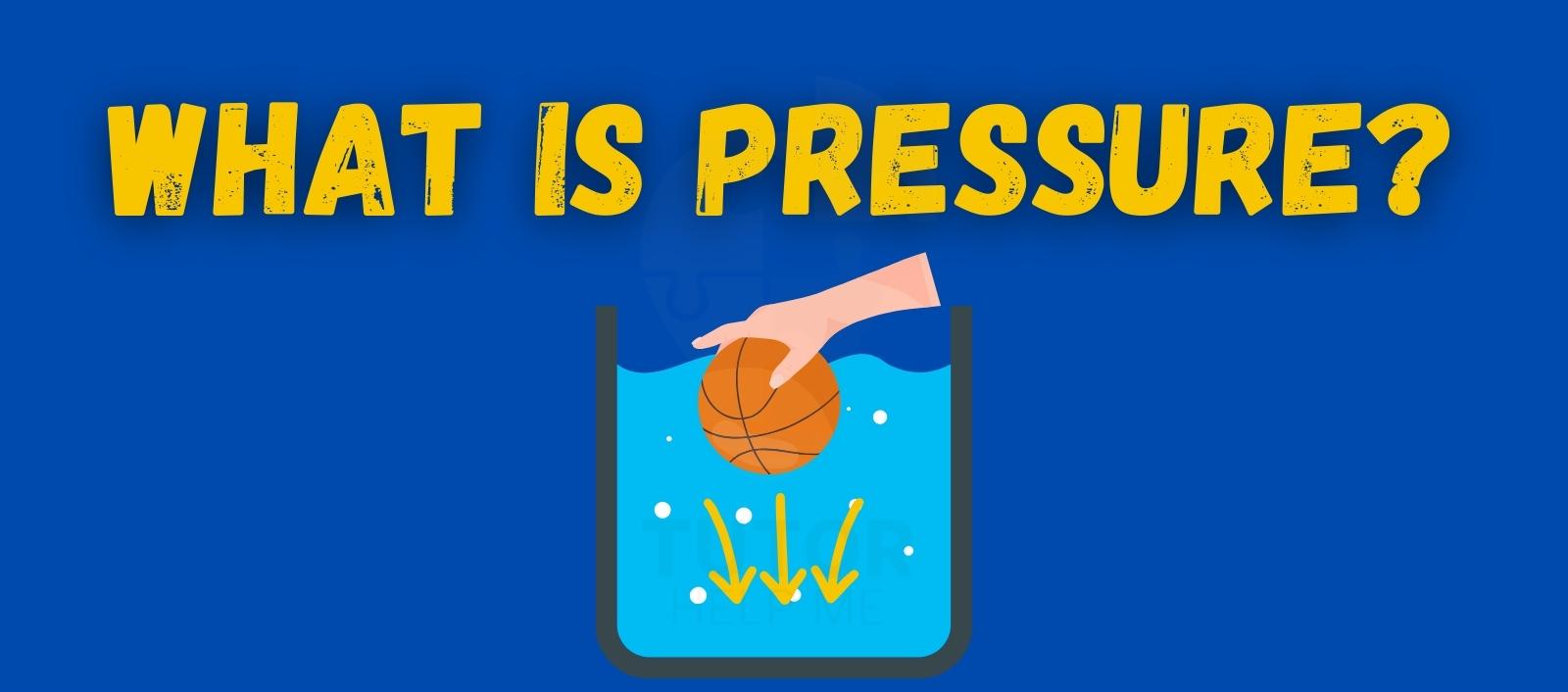Ever wondered how force spreads over an area? This guide will help you understand pressure.
Pressure is around you every day in air, water, tyres, and even inside your body. Knowing how it works helps you understand tools, weather, and machines.
In this guide, you’ll learn what pressure means, how to calculate it, what units it uses, and the types you may see in real life.
Let’s begin with the basics and see why pressure matters so much.
What is Pressure?
"Pressure is the force applied per unit area on a surface."
SI unit of pressure,
Pressure is measured in pascals (Pa) in the SI system.
Formula of pressure,
The formula of pressure is:
Pressure (P) = Force (F) / Area (A)
Example,
When a person stands on snow wearing boots, they sink slightly. However, using snowshoes, which distribute their weight over a larger area, they don’t sink as much. This happens because pressure decreases when the area increases.
Types of Pressure
These are the types of pressure:
- Atmospheric Pressure
- Gauge Pressure
- Absolute Pressure
- Hydrostatic Pressure
- Dynamic Pressure
Atmospheric Pressure
Atmospheric pressure is the force exerted by the weight of air above a surface.
Unit:
The SI unit is Pascal (Pa). It is also measured in atmospheres (atm) or millimetres of mercury (mmHg).
Formula:
P=ρ⋅g⋅h
Where:
- P = Pressure
- ρ = Air density
- g = Gravitational acceleration
- h = Height of the air column
Example:
At sea level, the atmospheric pressure is approximately 101,325 Pa (or 1 atm).
Gauge Pressure
Gauge pressure is the pressure measured relative to the atmospheric pressure. It excludes atmospheric pressure from its value.
Unit:
The SI unit is Pascal (Pa), but it can also be measured in bars or psi (pounds per square inch).
Formula:
Pg= P − Patm
Where:
- Pg = Gauge pressure
- P = Absolute pressure
- Patm = Atmospheric pressure
Example:
If the absolute pressure inside a tyre is 250,000 Pa and atmospheric pressure is 101,325 Pa, the gauge pressure is:
Pg = 250,000 − 101,325 = 148,675 Pa
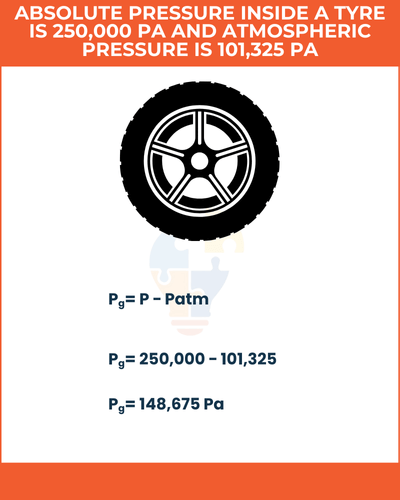
Absolute Pressure
Absolute pressure is the total pressure measured relative to a perfect vacuum. It includes atmospheric pressure.
Unit:
The SI unit is Pascal (Pa), but it can also be expressed in bars or psi.
Formula:
Pa = Pg + Patm
Where:
- Pa = Absolute pressure
- Pg = Gauge pressure
- Patm = Atmospheric pressure
Example:
If a gauge pressure in a car tyre is 200,000 Pa and atmospheric pressure is 101,325 Pa, the absolute pressure is:
Pa= 200,000 + 101,325=301,325 Pa
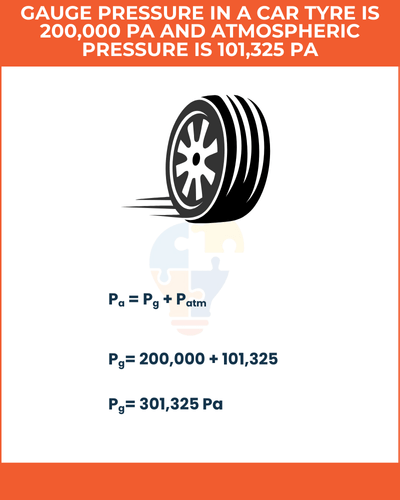
Hydrostatic Pressure
Hydrostatic pressure is the pressure exerted by a fluid at rest due to the force of gravity. It increases proportionally with the depth of the fluid.
Unit:
The SI unit of hydrostatic pressure is the Pascal (Pa), where 1 Pa = 1 N/m². Other common units include atmospheres (atm), bars, or pounds per square inch (psi).
Formula:
P=ρgh
Where:
- P = Hydrostatic pressure (Pa)
- ρ = Density of the fluid (kg/m³)
- g = Acceleration due to gravity (9.81 m/s2)
- h = Height (depth) of the fluid column (m)
Example:
Calculate the hydrostatic pressure at a depth of 10 m in water (ρ=1000 kg/m3)
P= ρgh = (1000)(9.81)(10) = 98,100Pa (or 98.1kPa)
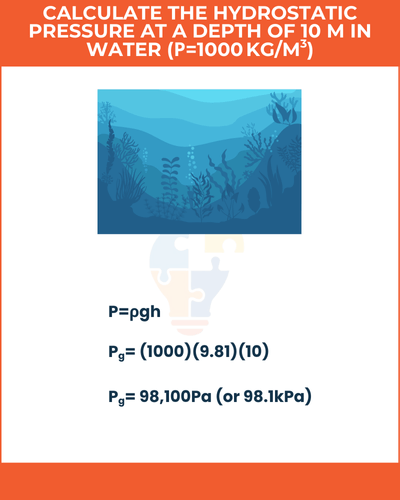
Dynamic Pressure
Dynamic pressure is the pressure associated with the kinetic energy of a fluid in motion. It represents the energy per unit volume of fluid flow.
Unit:
The SI unit of dynamic pressure is also the Pascal (Pa).
Formula:
q = 1/2ρv2
Where:
- q = Dynamic pressure (Pa)
- ρ = Density of the fluid (kg/m³)
- v = Velocity of the fluid (m/s)
Example:
Calculate the dynamic pressure of air (ρ=1.225 kg/m3) moving at a velocity of 50 m/s.
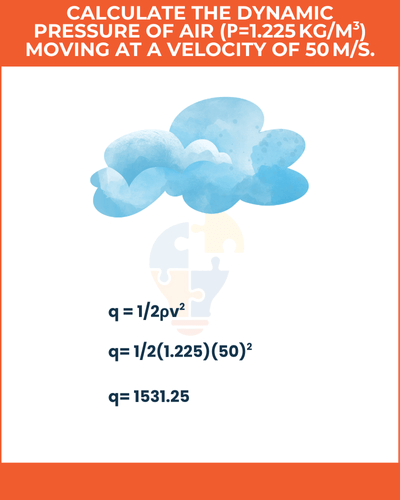
How Does Pressure Affect Everyday Life?
Pressure plays a role in many real-world applications, such as:
- Tyre pressure: Proper air pressure ensures better fuel efficiency and safety.
- Weather patterns: Low and high-pressure systems influence the UK’s climate.
- Hydraulic systems: Car brakes and lifts operate using fluid pressure principles.
How is Pressure Used in Weather Forecasting?
Meteorologists use barometers to measure atmospheric pressure.
- Low pressure usually brings rain and storms.
- High pressure is linked to clear skies and dry weather.
This is why checking pressure maps helps predict the UK’s changing weather conditions.
Why Do Aeroplanes Adjust Cabin Pressure?
At high altitudes, air pressure decreases, making it difficult to breathe.
- Aircraft cabin pressure systems adjust the air inside to ensure passenger comfort.
- Without pressure control, oxygen levels would drop, causing altitude sickness.
Why Choose Tutorhelpme Physics and Maths Tutor
- Expert Tutors: Highly qualified and experienced Physics and Maths Tutor specialising in Physics and Maths.
- Personalised Learning: Tailored lessons to suit individual learning styles and academic goals.
- Flexible Scheduling: Convenient timings to fit your busy schedule.
- Comprehensive Support: Assistance with homework, exam preparation, and conceptual understanding.
- Affordable Rates: High-quality tutoring at competitive prices.
- Interactive Online Sessions: Engaging and interactive virtual classes for better understanding.
- Proven Results: Track record of improved grades and student satisfaction.
- Access to Resources: Exclusive study materials, practice tests, and revision notes.
- One-on-One Attention: Dedicated focus to address specific challenges and queries.
- Boost Confidence: Encouraging teaching methods to enhance student confidence and performance.
- Global Accessibility: Available to students worldwide, ensuring quality education from anywhere.
- Ongoing Progress Monitoring: Regular feedback and progress tracking for continuous improvement.
Choose TutorHelpMe for a smarter, more efficient learning experience!
Read More What is Distance and Displacement? Distance Vs Displacement
FAQ’s
Why do my car tyres lose pressure in winter?
In colder weather, air contracts, reducing tyre pressure. This is why it’s recommended to check and adjust tyre pressure in winter to avoid reduced grip and fuel efficiency.
Why do my ears pop on a plane?
During takeoff and landing, cabin pressure changes rapidly, affecting the eardrum. Swallowing or chewing gum helps balance internal and external pressure.
How does pressure affect deep-sea diving?
As divers go deeper, water pressure increases, which can affect breathing and movement. This is why divers use pressurised air tanks and follow safety stops to avoid decompression sickness.
How does pressure affect train travel?
High-speed trains experience air resistance, which engineers counter using streamlined designs to reduce dynamic pressure and improve efficiency.
Why does boiling point change with altitude?
At higher altitudes, atmospheric pressure is lower, meaning water boils at a lower temperature. This is why boiling times differ in mountainous regions.
How does hydrostatic pressure affect dam construction?
Dams in the UK are designed to withstand hydrostatic pressure caused by stored water. Engineers calculate pressure distribution to ensure stability and safety.

